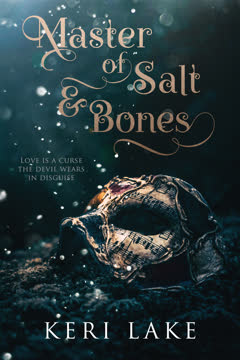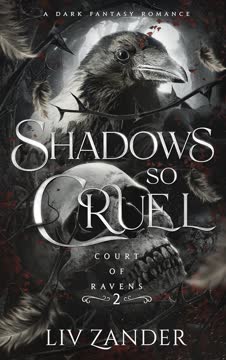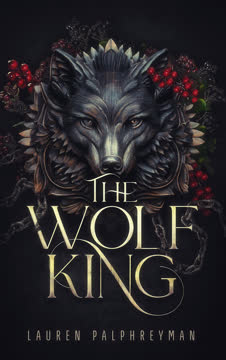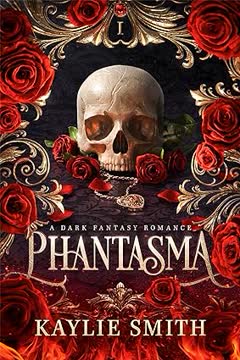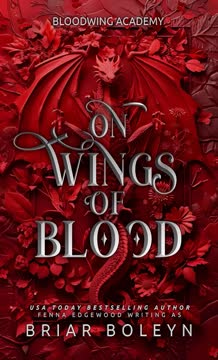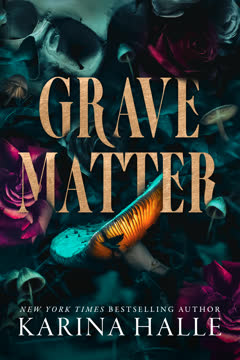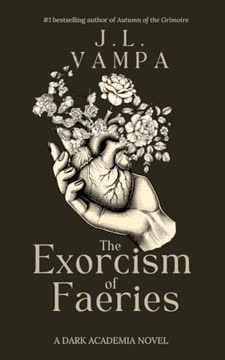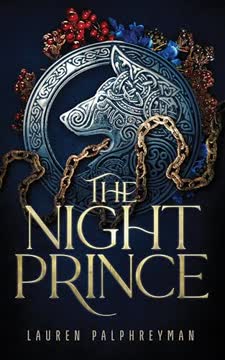Plot Summary
Prologue: Shackles and Shadows
Fifteen years ago, Lucian Blackthorne is forcibly committed to a shadowy institution by his parents, who believe he is "ill." Bound and drugged, he is subjected to cruel aversion therapies and psychological torment. His mother's tears and his father's coldness set the tone for a life shaped by trauma, suspicion, and the weight of a family legacy steeped in darkness. Lucian's earliest memories are of betrayal and pain, and the scars—both physical and emotional—will define his journey. The prologue establishes the novel's gothic atmosphere and the generational wounds that haunt the Blackthornes, foreshadowing the twisted love and violence to come.
Arrival at Bonesalt Manor
Isadora "Isa" Quinn, nineteen and desperate for money, accepts a job as companion to the ailing Mrs. Blackthorne at the infamous Bonesalt Manor. The locals warn her of the Blackthorne curse and Lucian's reputation as the "Devil of Bonesalt." Isa's own life is marked by poverty, her mother's addiction, and the town's scorn. As she arrives at the manor, she's struck by its decaying grandeur and the sense of being watched. The house is filled with secrets, and Isa's outsider status makes her both vulnerable and uniquely perceptive. Her first encounters with the staff and the house's eerie ambiance set her on a collision course with Lucian's world.
The Devil's Reputation
Lucian Blackthorne is a man of myth in Tempest Cove—rumored murderer, madman, and recluse. Isa's first meeting with him is charged with tension: he is scarred, both beautiful and terrifying, and their banter is laced with challenge and attraction. Lucian's presence is magnetic, but he is also deeply wounded, haunted by his past and the loss of his wife and son. The townspeople's superstitions and the Blackthorne family's isolation have created a legend around him, but Isa senses the pain beneath his armor. Their dynamic is immediately fraught, setting the stage for a relationship built on mutual fascination and danger.
Haunted by the Past
The narrative weaves between past and present, revealing Lucian's troubled adolescence: his friendship with Jude, his sexual awakening with the enigmatic maid Solange, and the violence that shaped him. The cave by the sea becomes a symbol of both freedom and peril, a place where Lucian's desires and fears collide. Solange's influence is intoxicating and destructive, blurring the lines between pleasure and pain. These memories haunt Lucian, informing his adult relationships and his inability to trust or love without violence. The past is never truly buried at Bonesalt; it seeps into every corner of the manor and every interaction.
The Blackthorne Curse
The Blackthorne family is plagued by rumors of a curse—said to be the result of a deal with a sea witch or siren. The truth is more insidious: generations of sadism, abuse, and secret societies. Lucian's father indoctrinates him into the Collective, a group that studies and perpetuates cruelty under the guise of science. The family's wealth is built on suffering, and Lucian is both victim and heir to this legacy. Isa, too, is marked by her mother's reputation as the "Siren of Tempest Cove," and the two protagonists are drawn together by their shared sense of being outsiders, cursed by blood and circumstance.
Secrets in the Castle
Bonesalt Manor is a labyrinth of locked doors, hidden passages, and rooms filled with strange collections—most notably, Mrs. Blackthorne's dolls. The house is a character in itself, reflecting the madness and decay of its inhabitants. Isa's curiosity leads her to uncover clues about the family's history, the fate of Lucian's wife and son, and the true nature of the Blackthorne curse. The castle's secrets are both literal and metaphorical, mirroring the psychological mazes the characters must navigate. The sense of claustrophobia and surveillance is ever-present, heightening the tension and sense of impending doom.
The Mad Son's Games
Lucian and Isa's relationship intensifies, oscillating between antagonism and desire. Lucian's need for control manifests in dangerous games—emotional, psychological, and sexual. Isa is both drawn to and repelled by his darkness, recognizing in him a reflection of her own trauma and longing. Their encounters are charged with violence and vulnerability, as each tests the other's boundaries. The power dynamics shift constantly, and the threat of real harm is never far away. Yet, in their twisted intimacy, both find a measure of solace and understanding that the outside world denies them.
Music and Madness
Music becomes a language of connection and catharsis for Lucian and Isa. Both are gifted pianists, and their shared sessions at the manor's grand piano allow them to express what words cannot. The act of playing—especially Lucian's original compositions—serves as a form of therapy, a way to process grief and rage. Isa's ability to play by ear astonishes Lucian and Mrs. Blackthorne, and the piano room becomes a sanctuary amid the chaos. Through music, the characters confront their madness, their longing, and the possibility of redemption, even as the shadows close in.
The Doll Collector
Mrs. Blackthorne, once a formidable matriarch, is now lost to dementia and delusion. Her obsession with dolls is both a symptom and a symbol of her fractured mind. Through her, Isa learns more about the family's history, the fate of Lucian's wife Amelia, and the missing grandson Roark. Mrs. Blackthorne's lucid moments are laced with bitterness and regret, and her interactions with Isa are alternately cruel and confiding. The old woman's secrets are key to understanding the tragedies that have befallen the Blackthornes, and her eventual confessions will shatter what remains of the family's illusions.
Nightmares and Truths
Isa's past is as haunted as Lucian's: her mother's addiction, her own history of self-harm, and the trauma of sexual assault. The narrative does not shy away from the brutality of survival—both Isa and Lucian have done terrible things to protect themselves and those they love. The town's hypocrisy and cruelty are laid bare, and the line between victim and perpetrator blurs. As Isa becomes entangled in the Blackthornes' world, she must confront her own capacity for violence and the price of her choices. The truth, when it comes, is both liberating and devastating.
The Masquerade Ball
A lavish masquerade ball at Bonesalt Manor brings together the island's elite and the shadowy members of the Collective. Isa is transformed, both literally and figuratively, as she dons a mask and an elegant dress. The event is a crucible for the novel's themes: identity, secrecy, and the performance of power. Lucian and Isa's attraction reaches a fever pitch, culminating in a dangerous, public display of passion. The ball also exposes the machinations of the Collective, the true nature of Lucian's alliances, and the lengths to which the powerful will go to protect their secrets.
Bloodlines and Betrayals
The revelation that Isa is the illegitimate daughter of Patrick Boyd—Lucian's former father-in-law and a member of the Collective—upends everything. Boyd's history of abuse and violence is exposed, and Isa becomes a pawn in a deadly game of power and revenge. The truth about Roark's parentage, Mrs. Blackthorne's crimes, and the fate of Amelia are all brought to light in a series of confessions and confrontations. Blood ties are both a curse and a weapon, and the characters must decide whether to perpetuate the cycle of violence or break free from it.
The Price of Protection
Lucian's willingness to kill to protect Isa—and Isa's own capacity for violence—force both to reckon with the darkness inside themselves. The lines between love and possession, protection and control, are blurred. The Collective's grip tightens, and the threat of exposure or retribution looms. Isa must decide whether to trust Lucian, even as she fears what he is capable of. The price of survival is high, and both must confront the question of what they are willing to sacrifice for each other.
The Siren's Daughter
Isa's journey is one of self-discovery as much as survival. She is the daughter of a "siren," a woman reviled and desired in equal measure, and her own gifts—musical, emotional, and intuitive—are both a blessing and a burden. The novel explores the ways in which women are punished for their power, and the struggle to claim agency in a world determined to define and confine them. Isa's relationship with Lucian is both a rebellion and a homecoming, a way to rewrite the story of her bloodline.
The Institute's Experiments
The Institute, where Lucian was once imprisoned, is revealed as a site of ongoing experimentation and abuse. The Collective's "research" is a cover for the perpetuation of generational trauma and the rationalization of sadism. Lucian's sessions with Dr. Voigt are a chilling reminder of the ways in which power disguises itself as science, and the ease with which suffering is justified in the name of progress. The Institute is a microcosm of the novel's larger themes: the inheritance of pain, the complicity of institutions, and the possibility of resistance.
The Collective's Grip
The Collective's influence is everywhere: in the town's politics, the Blackthorne family's fortunes, and the fates of Isa and Lucian. Surveillance, both literal and psychological, is a constant threat. The characters are watched, manipulated, and tested at every turn. Breaking free from the Collective's grip requires both cunning and courage, and the cost of defiance is high. The novel interrogates the nature of power—who wields it, who suffers under it, and what it takes to reclaim it.
Love in the Dark
Against all odds, Isa and Lucian find a measure of healing in each other. Their love is not a cure, but a form of resistance—a refusal to be defined by the violence and cruelty that shaped them. Music, touch, and shared vulnerability become acts of defiance. The novel does not offer easy answers or tidy resolutions, but it insists on the possibility of connection, even in the darkest of places. Love, here, is both dangerous and necessary, a madness that saves as much as it destroys.
The Final Confessions
In the aftermath of violence and revelation, the characters must confront the consequences of their choices. Mrs. Blackthorne's final confessions lay bare the full extent of the family's crimes. Lucian and Isa, scarred but unbroken, choose each other and a future outside the shadow of the Collective. The novel ends with a sense of hard-won hope: the possibility of writing a new story, of composing a new melody from the discordant notes of the past. The cycle of violence is not easily broken, but love—however flawed—offers a way forward.
Characters
Lucian Blackthorne
Lucian is the last of the Blackthorne line, a man marked by physical and psychological scars. Raised in a family that equates power with cruelty, he is both victim and perpetrator, struggling to break free from the legacy of the Collective. His relationships—with his parents, his wife, his son, and ultimately Isa—are shaped by trauma, obsession, and a desperate need for control. Lucian's psyche is a battleground between the desire for connection and the fear of vulnerability. His development is a slow, painful journey toward self-acceptance and the possibility of love, even as he remains capable of great violence.
Isadora "Isa" Quinn
Isa is a young woman forged in hardship: the daughter of a notorious addict, scorned by her community, and marked by her own history of trauma and self-harm. Her intelligence, musical talent, and resilience set her apart, but also make her a target. Isa's relationship with Lucian is both a lifeline and a crucible, forcing her to confront her own darkness and capacity for violence. She is fiercely loyal, quick-witted, and unafraid to challenge authority. Isa's journey is one of claiming agency, rewriting the story of her bloodline, and finding belonging in the most unlikely of places.
Mrs. Laura Blackthorne
Once a powerful figure, Mrs. Blackthorne is now lost to dementia and regret. Her obsession with dolls mirrors her need for control and her inability to process grief. Laura's confessions reveal her complicity in the family's crimes, including the deaths of Roark and Amelia. She is both victim and villain, shaped by the same forces that destroyed her husband and son. Her relationship with Lucian is fraught with bitterness and longing, and her interactions with Isa are a mix of cruelty and reluctant mentorship. Laura embodies the destructive power of secrets and the cost of refusing to confront the past.
Patrick Boyd
Boyd is the embodiment of the town's hypocrisy: a respected teacher and mayor with a history of abuse, manipulation, and violence. His affair with Isa's mother and subsequent rejection of both mother and child set in motion much of the novel's tragedy. Boyd's involvement with the Collective and his willingness to sacrifice Isa for power make him a chilling antagonist. His eventual downfall is both a reckoning and a warning about the dangers of unchecked authority and the ease with which evil hides behind respectability.
Solange
Solange is both real and imagined: a seductive maid from Lucian's youth who initiates him into the world of pain and pleasure. Her presence haunts Lucian, blurring the lines between memory and hallucination. Solange represents the allure and danger of forbidden desire, and her influence lingers long after her death. She is a symbol of the ways in which trauma can become eroticized, and the difficulty of distinguishing between healing and harm.
Jude
Jude is Lucian's childhood friend, whose death in the cave marks the end of innocence and the beginning of Lucian's descent into darkness. His memory is both a comfort and a torment, a reminder of what was lost and what might have been. Jude's presence in Lucian's hallucinations underscores the novel's themes of grief, guilt, and the persistence of the past.
Giulia
Giulia is a maid at Bonesalt Manor who, like Isa, has done whatever it takes to survive. Her arrangement with Lucian is transactional—sex in exchange for her daughter's education—but she is also a source of wisdom and warning. Giulia's fears about the Collective and her willingness to confide in Isa highlight the dangers faced by women in this world. She is both a cautionary tale and a testament to resilience.
Rand
Rand is Lucian's right hand, a man who has served the Blackthornes for decades. He is efficient, discreet, and deeply loyal, but not without his own moral ambiguities. Rand's role is to manage the household, protect the family's interests, and occasionally serve as Lucian's conscience. He is a bridge between the old world and the new, and his presence is a reminder of the costs of loyalty.
Makaio
Makaio is Lucian's bodyguard, a physically imposing figure with a surprising depth of empathy. He is instrumental in protecting Isa and dealing with threats to the family. Makaio's loyalty is to Lucian, but he is not blind to the moral complexities of his employer's actions. He represents the possibility of strength without cruelty, and his interventions are often the difference between life and death.
Dr. Friedrich Voigt
Dr. Voigt is the mastermind behind the Institute and the Collective's experiments. He is a chilling figure, rationalizing cruelty in the name of science and progress. Voigt's influence on the Blackthorne family is profound, shaping generations through manipulation and control. He is the embodiment of institutional evil, and his presence is a constant reminder of the dangers of unchecked power and the seductive allure of rationalization.
Plot Devices
Dual Timelines and Interwoven Narratives
The novel employs a dual timeline structure, weaving together Lucian's traumatic adolescence and Isa's present-day journey. Flashbacks are used to gradually reveal the origins of the Blackthorne curse, the nature of the Collective, and the personal histories that bind the characters. This structure allows for a slow unveiling of secrets, building suspense and deepening the reader's understanding of the characters' motivations. The interplay between past and present underscores the novel's central theme: the inescapability of history and the ways in which trauma is inherited and perpetuated.
Gothic Setting and Symbolism
Bonesalt Manor is more than a backdrop; it is a character in its own right. The house's decaying grandeur, labyrinthine corridors, and strange collections mirror the psychological states of its inhabitants. Dolls, mirrors, and locked rooms serve as symbols of repression, surveillance, and the fragmentation of identity. The recurring motif of the cave by the sea represents both danger and sanctuary, a place where the boundaries between life and death, pleasure and pain, are blurred. The gothic atmosphere heightens the sense of claustrophobia and impending doom.
The Collective and the Institute
The Collective is a shadowy organization that justifies cruelty in the name of science and progress. The Institute, where Lucian was once imprisoned, is a site of ongoing experimentation and abuse. These institutions serve as both literal and metaphorical representations of the machinery of power: they rationalize and perpetuate violence, turning personal trauma into a systematized legacy. The presence of surveillance, contracts, and rituals underscores the ways in which individuals are trapped by forces beyond their control.
Unreliable Narration and Hallucination
The novel frequently blurs the line between reality and hallucination, especially in Lucian's perspective. The presence of Solange, the shifting nature of memory, and the characters' struggles with mental illness create a sense of instability and uncertainty. This device forces the reader to question what is real and what is imagined, mirroring the characters' own confusion. The unreliable narration heightens suspense and allows for shocking revelations, as the truth is often hidden beneath layers of denial and manipulation.
Music as Metaphor and Connection
Music—especially the piano—serves as a recurring motif and a means of connection between Lucian and Isa. Their shared talent allows them to communicate beyond words, to process grief and rage, and to find moments of peace amid chaos. Music is both a metaphor for the novel's structure (with its recurring themes and variations) and a literal source of healing. The act of playing together becomes an act of resistance, a way to reclaim agency and rewrite the story of their lives.
Power Dynamics and Consent
The relationship between Lucian and Isa is fraught with issues of power, control, and consent. Their sexual encounters are charged with violence and vulnerability, reflecting their shared histories of trauma. The novel does not shy away from the dangers of these dynamics, but it also insists on the possibility of mutual understanding and healing. The constant negotiation of boundaries—both physical and emotional—is central to the characters' development and the story's emotional arc.
Foreshadowing and Symbolic Motifs
Recurring images—ravens, moths, dolls, the sea—serve as symbols of fate, transformation, and the inescapability of the past. The presence of the one-eyed raven, the death's-head moth, and the ever-present ocean all foreshadow key events and reflect the characters' inner turmoil. These motifs create a sense of inevitability and interconnectedness, reinforcing the novel's themes of inheritance, repetition, and the possibility of change.
Analysis
"Master of Salt & Bones" is a modern gothic romance that interrogates the legacy of trauma, the machinery of power, and the possibility of redemption in a world built on suffering. At its core, the novel is about the inheritance of pain—how violence, cruelty, and secrecy are passed down through generations, shaping not only families but entire communities. The Blackthorne curse is not supernatural, but systemic: a product of abuse, complicity, and the rationalization of evil. The novel's greatest strength lies in its refusal to offer easy answers or tidy resolutions. Love, here, is not a panacea, but a form of resistance—a way to reclaim agency, rewrite the story, and find meaning in the midst of madness. Isa and Lucian's relationship is both a crucible and a sanctuary, forcing them to confront their own darkness and the possibility of healing. The book's lessons are hard-won: that survival often requires violence, that forgiveness is not the same as forgetting, and that the only way out of the labyrinth is through. In a world where power is wielded through secrecy and pain, the act of telling the truth—of making music from discordant notes—is itself a revolutionary act.
Last updated:
Review Summary
Master of Salt & Bones is a dark, gothic romance that polarizes readers. Many praise its atmospheric setting, complex characters, and twisting plot, while others find it disturbing and overly long. The story follows Lucian Blackthorne, a mysterious and troubled man, and Isadora Quinn, a young woman who becomes entangled in his world. Themes of abuse, violence, and forbidden love are prevalent. Some readers appreciate the author's writing style and character development, while others struggle with the age gap and explicit content. Overall, it's a divisive book that elicits strong reactions.
